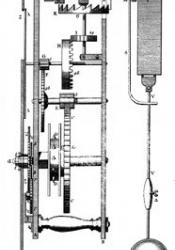Pendulum Clock
The first pendulum clock was invented in 1656 by a Dutch scientist named Christian Huygens. He allegedly spent all of Christmas day in the Hague constructing his model. Although Galileo Galilei is often credited with studying and inventing the pendulum in the late 16th century, his clock designs were never built. Although the pendulum clock was invented in the Netherlands, it became most prevalent among English clockmakers. By 1671 the “grandfather clock” design we know today was becoming widespread in England and later the rest of Europe. Around this time, a man named William Clement created a new mechanism, the anchor escapement, as well as the pendulum suspension spring. These further increased the accuracy of pendulum clocks. At this point, pendulum clocks could be accurate to less than 10 seconds a day, which was orders of magnitude more accurate than previous clock designs. Because of this newfound accuracy, London clockmaker Daniel Quare added minute and second hands to the clock, allowing time to be read more accurately than ever before. This type of clock dominated timekeeping for centuries, until the electric clock became prevalent in the 19th century.
Sources: “Accurate Mechanical Clocks.” The History of Mechanical Pendulum Clocks and Quartz Clocks. 7 April 2017. https://www.thoughtco.com/history-of-mechanical-pendulum-clocks-4078405. Accessed 8 Mar 2018.
Gascoigne, Bamber. “History of Clocks.” HistoryWorld. From 2001, ongoing. http://www.historyworld.net/wrldhis/PlainTextHistories.asp?groupid=1244&HistoryID=ac08>rack=pthc. Accessed 8 Mar 2018.
Image: Wikipedia Commons, public domain. https://commons.wikimedia.org/wiki/File:Early_Pendulum_Clock_Christian_H...

